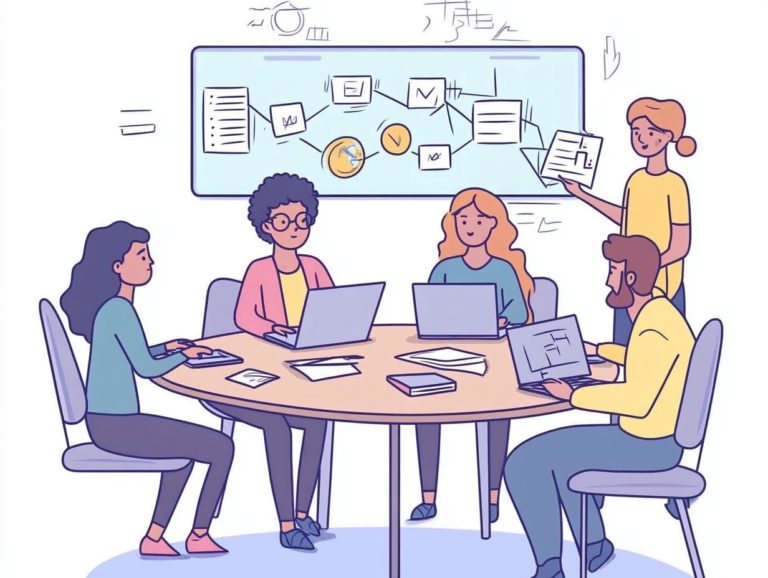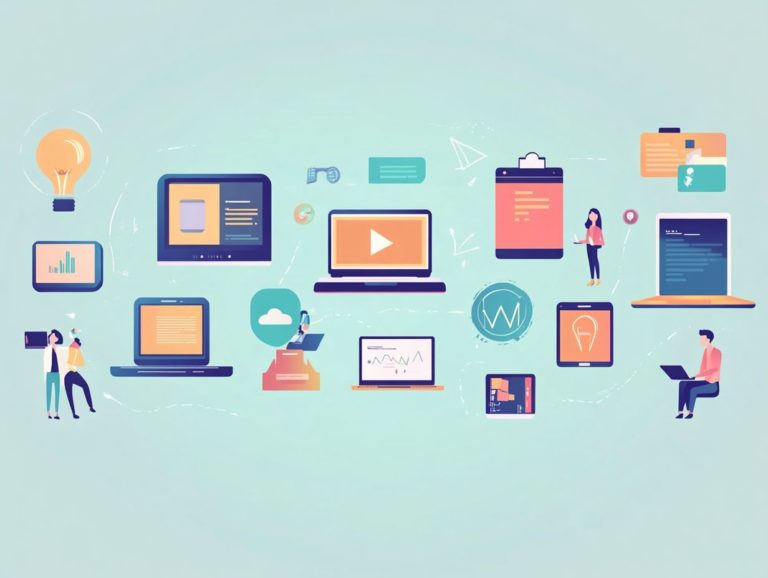Using E-Learning for Talent Development Strategies
Effective talent development is critical in today s fast-paced business landscape. Organizations are increasingly embracing e-learning to cultivate skills and enhance employee performance.
This article delves into the many benefits of e-learning, highlighting its efficiency, cost-effectiveness, and tailored approach to addressing specific training needs. The article also discusses best practices for crafting engaging content and monitoring progress.
Whether you re in a managerial role or a valued team member, grasping these strategies can profoundly elevate your workforce s potential.
Contents
- Key Takeaways:
- Defining Talent Development and its Importance
- Benefits of Using E-Learning for Talent Development
- Implementing E-Learning for Talent Development
- Best Practices for E-Learning in Talent Development
- Engaging and Interactive Content
- Personalized Learning Paths
- Tracking and Measuring Progress
- Frequently Asked Questions
- 1. How can using e-learning benefit my talent development strategies?
- 2. What types of content can be included in e-learning for talent development?
- 3. How can e-learning be cost-effective for talent development?
- 4. Is e-learning suitable for all types of talent development strategies?
- 5. Can e-learning be accessed on mobile devices?
- 6. How can I measure the effectiveness of e-learning in my talent development strategies?
Key Takeaways:

- E-learning is a cost-effective way to develop talent.
- Identify training needs and select the right platform.
- Incorporate engaging content and track progress.
Defining Talent Development and its Importance
Talent development involves a range of planned learning activities tailored to enhance your skills and competencies, ensuring that your organization remains competitive in an ever-evolving marketplace. With the rise of e-Learning technologies, businesses are increasingly prioritizing personalized training programs for companies designed to address skill gaps, particularly among the Millennial workforce, who desire personalized learning experiences.
This generation thrives on flexible, interactive learning platforms that can be accessed anytime, anywhere, allowing them to seamlessly balance personal and professional development.
By investing in robust e-Learning systems, organizations can quickly close skill gaps and demonstrate a genuine commitment to employee growth an essential component of any effective retention strategy.
Engaging and relevant training programs can significantly enhance job satisfaction, making employees feel valued and supported. As organizations adapt to these changing dynamics, they position themselves as desirable employers in a competitive landscape, ultimately securing a loyal, skilled, and motivated workforce.
Benefits of Using E-Learning for Talent Development
Leveraging e-Learning for talent development presents many benefits that can elevate traditional corporate training models into vibrant and engaging learning experiences. This approach helps your employees develop continuously.
As automation reshapes the landscape and the demand for strategic learning intensifies, e-Learning platforms empower organizations to adopt engagement strategies that truly resonate with the Millennial workforce. The result? Enhanced employee retention and a notable boost in workplace productivity.
Efficiency and Effectiveness
E-Learning offers you a highly efficient and effective platform for corporate training by integrating advanced learning management systems that streamline the training process and boost workplace productivity. This approach gives the power to talent developers to design and deliver training courses tailored to individual learning styles and preferences, ensuring you receive the most relevant information and skills you need.
By harnessing technologies that adjust to how you learn best, your organization can personalize the training experience in real time, allowing you to progress at your own pace. For instance, platforms utilizing artificial intelligence can analyze your performance, adjusting the content’s difficulty to optimize retention and understanding.
A well-crafted e-Learning course, featuring interactive simulations or gamified modules, not only captivates you but also reinforces the application of new skills in your role. As a result, you are far more likely to retain knowledge, leading to improved performance metrics and a boost in overall productivity within the workforce.
Cost Savings

One of the most compelling advantages of e-Learning is its remarkable ability to deliver substantial cost savings for your organization by minimizing the expenses tied to traditional corporate training methods. This includes slashing costs related to travel, venue bookings, and printed materials, making online training a far more economical choice for employee onboarding and development.
For instance, a study by the International Data Corporation reveals that organizations can save between 30-50% on training costs when they choose e-Learning over in-person sessions. Companies like IBM have reported striking returns on investment, estimating that for every dollar spent on e-Learning, they enjoy around $30 in productivity gains.
These significant savings can be redirected toward other talent development initiatives, such as mentoring programs or advanced skills training, ultimately nurturing a workforce that is more skilled and adaptable. By leveraging these savings, your organization can cultivate a culture of continuous learning, ensuring it remains competitive in an ever-evolving market.
Implementing E-Learning for Talent Development
Implementing e-Learning for talent development demands a strategic approach to pinpoint training needs and select the right learning technology that aligns seamlessly with your organizational goals.
By leveraging online resources, you can customize your training programs to effectively bridge specific skill gaps and elevate employee engagement especially among Millennials, who truly excel in digital learning environments.
Identifying Training Needs
Identifying your training needs is a pivotal first step in implementing e-Learning. It enables you to assess existing skill gaps and tailor your training programs accordingly. By leveraging various methods such as employee feedback, performance reviews, and coaching sessions you can pinpoint the specific areas where your team requires additional support.
Conducting surveys and utilizing data analytics will provide you with deeper insights into workforce competencies and learning preferences. Analyzing this data not only highlights your training priorities but also helps align your programs with organizational goals.
Coaching and consistent feedback are essential for refining these training initiatives. By fostering open communication and regularly assessing employee progress, you can adapt your offerings to better meet the evolving needs of your workforce, cultivating a culture of continuous improvement and skill enhancement.
Choosing the Right E-Learning Platform
Choosing the right e-Learning platform is crucial for the success of your talent development initiatives, as it directly impacts employee engagement and the overall learning experience. You should carefully evaluate various learning management systems based on their features, scalability, and how well they align with your specific training objectives.
Usability is a key factor to consider. An intuitive interface can significantly enhance the user experience, making it much easier for employees to navigate and absorb content effectively.
Integration capabilities are also vital; the platform should connect seamlessly with your existing software tools to streamline workflows and data management. Robust support services are essential for addressing technical issues and providing guidance, ensuring that learners receive the assistance they need when challenges arise.
By selecting the right technology, you not only foster engagement but also promote continuous development, empowering your employees to acquire new skills and apply them confidently in their roles.
Best Practices for E-Learning in Talent Development

Implementing best practices in e-Learning is essential for maximizing its effectiveness in talent development. This ensures that employees remain engaged and motivated throughout their learning journeys.
Consider strategies like:
- crafting personalized learning paths,
- integrating gamification techniques, and
- offering continuous feedback.
These approaches can greatly enhance the learning experience and foster more effective skill acquisition.
Engaging and Interactive Content
Engaging content is your secret weapon for successful e-Learning! It captivates learners’ attention and fosters a deeper understanding of complex concepts. By integrating game-like elements and interactive media, you can enhance employee engagement and transform learning experiences into something truly enjoyable.
Several effective strategies can elevate this learning experience. For instance, incorporating quizzes allows learners to test their knowledge in real-time, providing instant feedback that reinforces understanding. Simulations immerse participants in realistic scenarios that challenge them to apply their skills practically, making the training more relevant.
Adding multimedia elements like videos, infographics, and interactive timelines can break up text-heavy content, catering to various learning styles. Gamification strategies, such as leaderboards and achievement badges, motivate learners to strive for mastery while promoting a sense of healthy competition, keeping them engaged and committed to their educational journey.
Personalized Learning Paths
Personalized learning paths in e-Learning empower learners to engage with content specifically tailored to their unique needs and career aspirations, fostering effective employee development and continuous growth. By evaluating individual progress and preferences, organizations can provide targeted training that precisely addresses skill gaps.
Such personalized approaches elevate motivation by aligning training with interests and enhance retention, as learners find it easier to remember information that resonates with their career trajectory.
To implement these tailored training initiatives effectively within e-Learning platforms, businesses can harness data analytics to monitor interactions and performance. This allows them to adjust content dynamically to suit each learner s journey. Incorporating elements like gamification or cohort-based challenges cultivates an engaging learning environment, nurturing a sense of community while boosting individual accountability and progress.
Tracking and Measuring Progress
Tracking and measuring progress in e-Learning is essential for evaluating the performance of training programs and ensuring that employees develop the necessary skills to boost workplace productivity. By harnessing analytics and feedback mechanisms, organizations can gain valuable insights into learning outcomes and make informed, data-driven decisions for continuous improvement.
This process involves using various assessment tools such as quizzes, tests, and peer evaluations to provide measurable results for assessing learner performance. Feedback systems, including surveys and interactive discussions, give participants the opportunity to share their experiences, enriching understanding of the program’s effectiveness.
Integrating data analytics is key to refining training strategies; it helps identify learning gaps and opportunities for enhancement, ultimately leading to more targeted and effective training outcomes. By continuously monitoring these aspects, organizations can adapt e-Learning environments to better meet the evolving needs of their workforce.
Frequently Asked Questions

1. How can using e-learning benefit my talent development strategies?
E-learning offers a variety of interactive and engaging tools that can enhance employee learning and development, leading to improved skills and knowledge transfer.
2. What types of content can be included in e-learning for talent development?
E-learning can include a wide range of content such as videos, simulations, quizzes, and interactive activities that support different learning styles and cater to various skill levels.
3. How can e-learning be cost-effective for talent development?
E-learning eliminates the need for in-person training, which can be expensive in terms of travel and venue costs. E-learning also makes tracking and reporting of employee progress easy, saving time and resources.
Explore the benefits of e-Learning today and take your talent development strategies to the next level!
4. Is e-learning suitable for all types of talent development strategies?
Yes, e-learning can be customized to meet your talent development needs.
It s suitable for onboarding, improving skills (upskilling), compliance training, and more.
5. Can e-learning be accessed on mobile devices?
Yes, most e-learning platforms are mobile-friendly.
This allows employees to access training anytime and anywhere, perfectly fitting busy schedules and remote work.
6. How can I measure the effectiveness of e-learning in my talent development strategies?
E-learning includes tracking and reporting features.
These help you measure employee progress and performance. You can also conduct surveys and assessments to gather feedback from employees and evaluate the impact of e-learning on their development.






